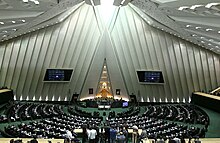Majlis (Iran)
|
Islamic Consultative Assembly مجلس شورای اسلامی Majles-e Showrā-ye Eslāmī |
|
|---|---|
|
34th Majles 10th Islamic Consultative Assembly |
|
 |
|
| Type | |
| Type | |
| History | |
| Founded | November 16, 1906 March 14, 1980 (current form) |
| Preceded by | National Consultative Assembly |
|
New session started
|
28 May 2016 |
| Leadership | |
|
First Deputy
|
|
|
Second Deputy
|
|
|
Wilayat fraction leader
|
Hamid-Reza Haji Babaee
Since 23 October 2016 |
|
Hope fraction leader
|
Mohammad Reza Aref
Since 20 July 2016 |
|
Wilayi Independents fraction leader
|
Kazem Jalali
Since 28 February 2017 |
| Structure | |
| Seats | 290 |
 |
|
|
Political groups
|
|
|
Length of term
|
4 years |
| Elections | |
| Qualified majority two-round system | |
|
Last election
|
26 February and 29 April 2016 |
| Meeting place | |
 |
|
| Islamic Consultative Assembly Baharestan Tehran Iran |
|
| Website | |
|
http://www.Majlis.ir http://parlemannews.ir/ http://www.icana.ir/ |
|
| Constitution | |
| Constitution of Islamic Republic of Iran | |
The Islamic Consultative Assembly (Persian: مجلس شورای اسلامی, translit. Majles-e Showrā-ye Eslāmī), also called the Iranian Parliament, the Iranian Majlis (or Majles, مجلس), is the national legislative body of Iran. The Parliament currently has 290 representatives, changed from the previous 272 seats since the 18 February 2000 election. The most recent election took place on 26 February 2016 and the new parliament was opened on 28 May 2016.
Before the Islamic Revolution, Majlis was also the name of the lower house of the Iranian Legislature from 1906 to 1979, the upper house being the Senate.
It was created by the Iran Constitution of 1906 and first convened on 7 October 1906 (Iranian Calendar: 1285-Mehr-13), soon gaining power under the rule of the Shah Mohammad Reza Pahlavi. Noteworthy bills passed by the Parliament under the Pahlavi Dynasty include the Oil Nationalization Bill (15 March 1951) and the Family Protection Law (1967), which gave women many basic rights such as custody of children in the case of divorce.
Women were not allowed to vote or be elected to the Parliament until 1963, as part of reforms under the Shah's "White Revolution". The twenty-first National Consultative Assembly, which included female representatives, opened on 6 October 1963.
The last session of the Pre-Revolution Parliament was held on 7 February 1979 (18 Bahman 1357 AP).
...
Wikipedia
